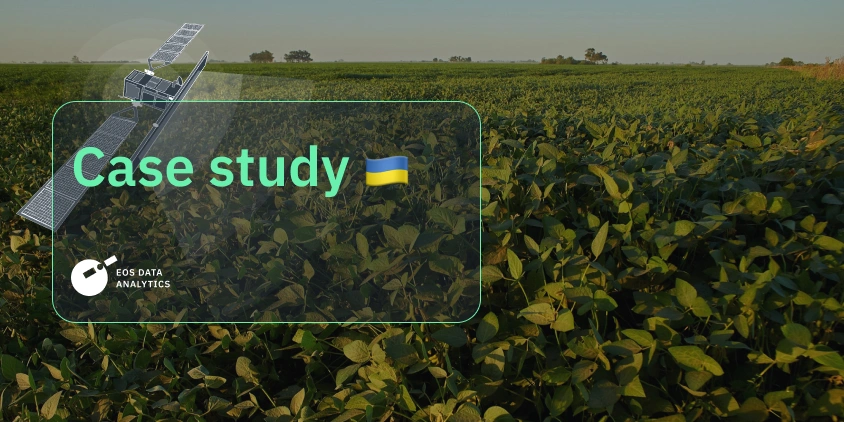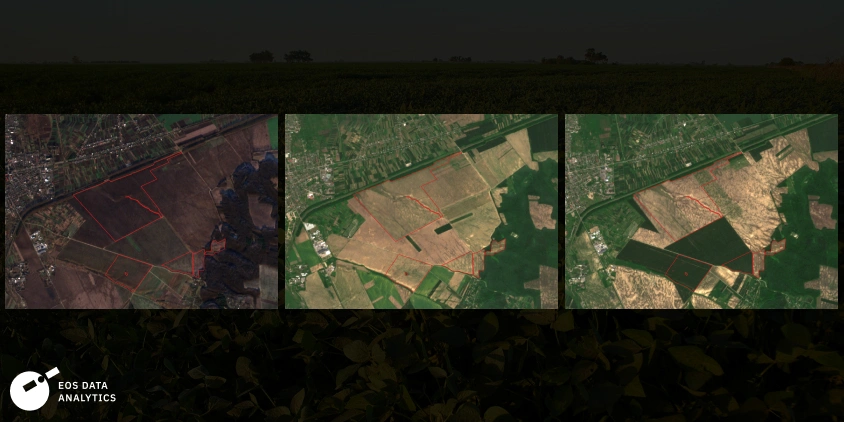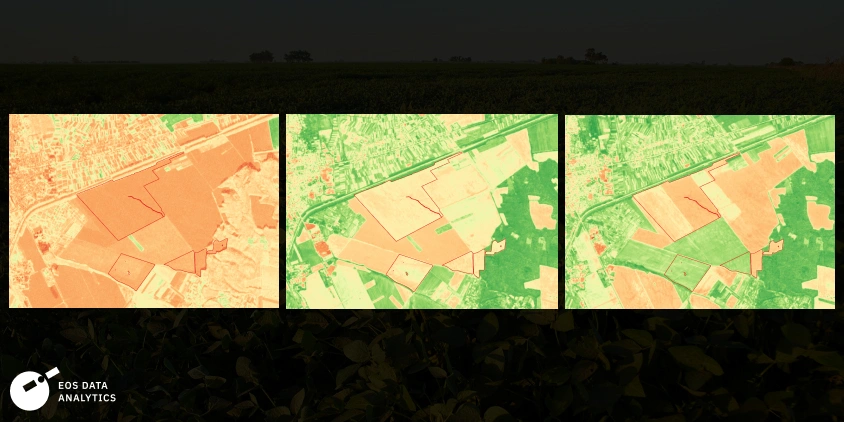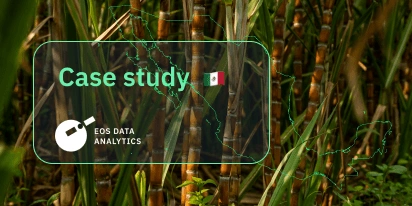
EOSDA With Crosscheck Analyzes Soybean Fields For EUDR
On June 29, 2023, the EU introduced the European Union Deforestation Regulation (EUDR) to reduce the environmental impact of global commodity trade and promote sustainable production practices. Under this regulation, companies exporting key agricultural commodities to the EU must prove that these goods are not associated with deforestation after December 31, 2020. EUDR covers agricultural products like soy, coffee, and palm oil, and applies to all actors in the supply chain . One of the core requirements is that each plot of land used in production be geolocated and confirmed as deforestation-free through credible evidence, including satellite data.
LLC “Zakhidna Ahrovyrobnycha Kompaniya,” a Ukrainian producer of cereals, legumes, and oilseed crops, exports soybeans to the European Union. The company initiated a verification process for 122 of its fields to ensure compliance with EUDR criteria.
To assist in the verification process, EOS Data Analytics (EOSDA), a global provider of satellite-powered agricultural monitoring, and Crosscheck, an innovative B2B SaaS platform that helps companies prepare for compliance audits, analyzed Zakhidna Ahrovyrobnycha Kompaniya’s fields. By combining RGB satellite imagery, NDVI interpretation, and precise geolocation data, EOSDA helped the company verify that its soy production meets EUDR requirements. Together, EOSDA and Crosscheck are able to deliver a full-cycle compliance solution: Crosscheck manages collecting information and preparing all necessary documents to prove the legality, while EOSDA focuses on delivering high-precision satellite analytics.
| Challenge | Zakhidna Ahrovyrobnycha Kompaniya needed to confirm that its soy production in 122 plots in Ukraine meets the EUDR standards. |
| Solution | EOS Data Analytics performed a detailed visual inspection and NDVI analysis of the company’s soy fields based on the images from 3 periods. Crosscheck prepared EUDR policies and other documentation to prove the legality of the product. |
| Outcome | The satellite imagery analysis revealed no forest clearing throughout the observed period, indicating lawful and sustainable land use by Zakhidna Ahrovyrobnycha Kompaniya. |
Overview: About The Zakhidna Ahrovyrobnycha Kompaniya And Its Soy Exports
LLC “Zakhidna Ahrovyrobnycha Kompaniya” is a Ukrainian company that produces cereals (excluding rice), legumes, and oilseed crops. In 2024, the company cultivated soy for export to the European Union.
The typical journey of their soy begins with planting and growing in Ukrainian fields. After harvesting and sorting, the product is stored and then sent out for export. It is cleared through Ukrainian customs and transported to the EU by ship, truck, or train. Once in the EU, the cargo is received, cleared, and sold on the market. Every part of this route must be checked for compliance with the EU Deforestation Regulation.
First of all, the company must prove that its soy is grown on land that hasn’t been recently deforested. The goal of this project was to help the company check its supply chain and confirm that it meets the new EU rules.
Challenge: Accurate Interpretation Of Remote Sensing Data
Confirming that soybean cultivation meets the EUDR standards requires not only checking official documentation and inspecting fields, but also a detailed land cover analysis based on remote sensing data. The goal is to verify that no deforestation or forest degradation occurred after the EU’s cut-off date. But ensuring this with confidence presents several challenges.
One of the main challenges is choosing the optimal images for visual analysis, which requires GIS expertise. Furthermore, shadows, seasonal variations, or cloud cover can distort the view. Therefore, in doubtful cases, several images from the peak growing season are needed.
The key task in this project was to select the optimal dates for analysis and make sure that all fields were covered by images of sufficient quality. Special attention was also needed for fields with ambiguous interpretation, such as the shadowed ones, where multiple images were used to confirm the results.
NDVI (normalized difference vegetation index) is typically used to reinforce natural color imagery-based findings, but it is context-dependent. Type of vegetation, season, geographical zone, among other factors, affect the values. Since there’s no globally accepted NDVI scale that applies to all regions, the index must be interpreted carefully within context.
These challenges made the process of interpreting remote sensing data more demanding. The following section explains how the EOSDA team dealt with these challenges and ensured that their findings were reliable.
Solution: Visual RGB Imagery Interpretation And Local-Adjusted NDVI Analysis
To make sure no deforestation happened after the EU cut-off date, the EOSDA science team used a step-by-step method combining satellite analysis and local context-based interpretation. First, the exact location and boundaries of each field were confirmed. This was done using GPS coordinates collected during on-site inspections. The coordinates were then checked against high-resolution satellite images and official maps. EOSDA and Crosscheck carried out this together to make sure the results were accurate and up to EU standards.
Our collaboration with EOSDA on this project shows how combining specialized expertise results in solid, effective solutions. We take care of the key bureaucratic tasks, like gathering & preparing documentation and client inputs, while EOSDA provides reliable visual evidence through satellite analysis. This collaboration allows us to deliver a smooth, end-to-end compliance reporting process that helps clients navigate EUDR requirements with confidence.
The core of the analysis was a detailed visual inspection of Sentinel-2 satellite images in natural color (RGB). These 10-meter-resolution images, precise enough to discern forest cover and potential clearing on farmland, were first pre-processed using automatic and semi-automatic pipelines. To avoid errors caused by clouds or shadows, we’ve filtered for scenes with less than 5% cloudiness and used only processed Sentinel-2 L2A images. This helped reduce the time spent on manual work while also improving accuracy. In some cases, Sentinel-1 radar images with a 10-meter resolution were also used to support interpretation.
Three sets of images were chosen for each field. These included:
- images from the peak growing season in 2020 to capture the state of vegetation before the official EUDR monitoring period began;
- images from the peak growing season in 2025, the most recent ones to enable a fair comparison under conditions similar to the 2020 peak growing season;
- one image as close as possible to December 31, 2020 to meet the formal requirement of verifying land cover at the EUDR cut-off date.
June–July is the peak growing season in Ukraine, when forests and crops show high chlorophyll activity. This makes it easier to visually detect forest cover in both natural color and near-infrared ranges. When visibility was unclear due to shadows or clouds, more than one image from the high vegetation period was used for comparison.

Although NDVI imagery analysis was not the primary tool, it was an important part of the process. The team used it to measure vegetation density and highlight abnormal areas. Because NDVI values depend on the season, land use, and region, the EOSDA science team applied a locally adjusted scale specifically designed for Ukrainian conditions.
This local scale helped put NDVI values in context. For example, NDVI values between 0.5 and 0.7 indicate dense, healthy forest cover during peak growing season in Ukraine. In combination with RGB images, this helped confirm whether forest loss had taken place or not.

Still, the key to the analysis was the visual interpretation of RGB images. Automation helped prepare better images. NDVI added context. But it was expert interpretation of high-quality, natural-color imagery that remained the most trustworthy way to confirm EUDR compliance.
Outcome: Verified Land History That Supports EUDR Compliance
Satellite data analysis confirmed that the agricultural land used by Zakhidna Ahrovyrobnycha Kompaniya remained unchanged throughout the monitored period. Across all 122 fields submitted for analysis, no deforestation was found between December 2020 and June 2025. Even earlier imagery shows no forest cover in these areas, confirming that cultivation did not involve any prior clearing of natural forest.
This consistency supports the conclusion that the production areas used by the company pose no environmental risk related to deforestation. The fields with no visible signs of land conversion are located in a country designated as low-risk by the European Commission, which reinforces this conclusion.
With the EUDR coming into effect soon, ensuring compliance is essential. We’re relieved to have successfully prepared some of our fields and gained valuable experience that can now be applied across the rest. Thanks to comprehensive services, from precise satellite analysis to preparing thorough documentation by EOSDA and Crosscheck, we feel well-equipped to meet these new requirements smoothly and without setbacks.
For buyers and partners, this outcome proves Zakhidna Ahrovyrobnycha Kompaniya’s ability to meet international sustainability standards without disruptions. This case highlights how satellite-based monitoring can provide reliable, large-scale support for regulatory checks under the EU Deforestation Regulation.
About the author:
Maksym Sushchuk is at the forefront of realizing EOSDA's vision to make space tech a global driver of sustainability on Earth. He has over 15 years of experience in journalism and content creation for prominent Ukrainian startups, charitable funds and ESG businesses. As Head and Co-founder of PR Army Maxim brings attention to the human and social tolls of the aggression against Ukraine.
Recent articles

Analyze 2025 & Plan Your Best Year Yet: LandViewer Christmas Offer
It’s the most wonderful time of the year! The Christmas holidays are here, and so is your chance to analyze 2025 and plan a prosperous 2026 with more affordable Pro plans in LandViewer.

EOSDA Models Climate Change Impact On Sugarcane Yields
EOSDA modeled future temperature, rainfall, and other climate impacts on Veracruz sugarcane. The results help growers plan long-term adaptation strategies, including timing, varieties, and irrigation.

EOSDA LandViewer Black Friday Sale: Exclusive Offers & Giveaway
This Black Friday, LandViewer offers new users the chance to save on monthly plans, get extra months with yearly subscriptions, and participate in a free annual plan giveaway.